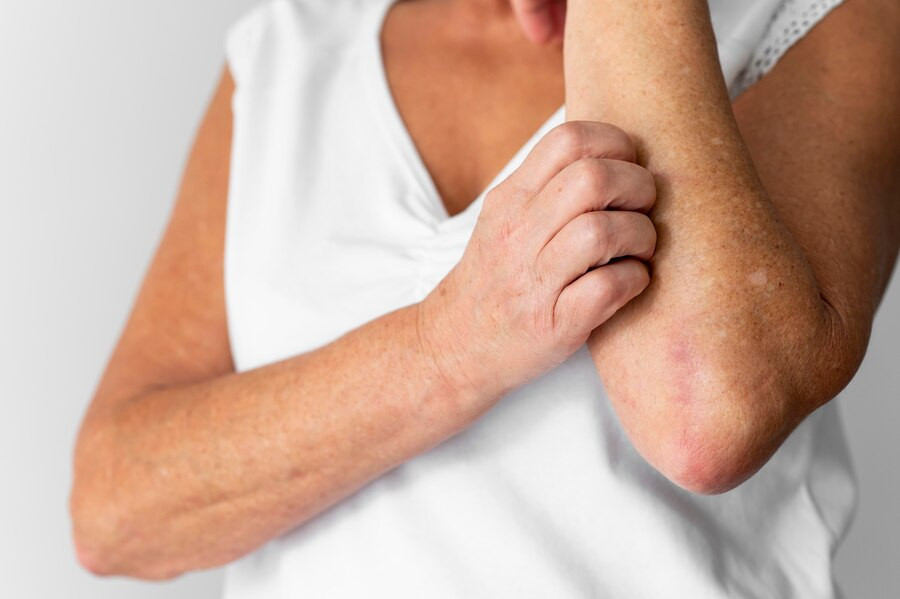Autoimmune disorders are caused when the immune system attacks the body's normal tissues. When the immune system is not functioning properly, it can lead to a variety of health issues. These disorders affect specific parts of the body. Some can cause skin irritations like rashes, red patches, hair loss, skin discoloration, itching, or pain.
Autoimmune skin conditions
Psoriasis
Psoriasis is an autoimmune skin condition in which the immune system overreacts and causes skin cells to grow more quickly. This condition causes skin cells to accumulate and form red plaques covered in silvery-white scales.
Psoriasis symptoms range from mild to severe, and skin plaques can appear anywhere on the body, but the elbows, knees, and torso are the most commonly affected. Psoriasis can cause physical and emotional discomfort for sufferers due to its chronic nature and flaring.
Scleroderma
Scleroderma is an autoimmune condition in which the immune system produces an excessive amount of collagen, a protein required for healthy skin and body tissues. Scleroderma thickens and hardens tissues such as the skin, blood vessels, and internal organs.
Scleroderma symptoms include skin thickening and hardening, skin discoloration, blood vessel damage, disruption of internal organs such as the lungs, heart, and gastrointestinal tract, muscle weakness, and joint pain.
Cutaneous Lupus
Cutaneous lupus is an autoimmune disease that manifests as a red, scaly rash on the skin. Sun exposure can cause or worsen some lupus rashes, so managing sun exposure is critical for people with cutaneous lupus.
Dermatomyositis
Dermatomyositis is an inflammatory autoimmune disease identified by muscle weakness and a distinctive skin rash. It can affect both adults and children, but is more common in people in their late 40s or early 60s.
Pemphigus
Pemphigus is a disease that causes blistering of the skin. It can affect the insides of the mouth, nose, throat, eyes, and genitals. This autoimmune condition creates painful blisters and sores that frequently burst, leaving open wounds. Without proper treatment, the sores are susceptible to infection.
Epidermolysis Bullosa
Epidermolysis bullosa (EB) is a rare autoimmune condition that affects both the skin and the mucous membranes in the body. It is caused by the body's inability to produce proteins that strengthen the structure and connect the layers of the skin. This condition weakens the skin and makes it susceptible to blisters caused by friction.
Autoimmune disorders are incurable diseases. The treatment's goal is to control the body's overactive immune response and reduce inflammation. Appropriate treatment can help control symptoms while preventing long-term damage to affected organs or tissues. Consult your doctor if you are experiencing autoimmune symptoms in your skin or other organs.
If you need medical advice or consultation, you can either visit a doctor or make use of the consultation features that are available in the Ai Care application by downloading the Ai Care application from the App Store or Play Store.
Looking for more information about other diseases? Click here!
- dr. Monica Salim
Lana Barhum (2024). Autoimmune Skin Disorders. Available from: https://www.verywellhealth.com/autoimmune-skin-conditions-5084066
Medline Plus (2024). Autoimmune Diseases. Available from: https://medlineplus.gov/autoimmunediseases.html
Mayo Clinic (2024). Psoriasis. Available from: https://www.mayoclinic.org/diseases-conditions/psoriasis/symptoms-causes/syc-20355840
Cleveland Clinic (2023). Scleroderma. Available from: https://my.clevelandclinic.org/health/diseases/scleroderma
Cleveland Clinic (2021). Cutaneous Lupus (Skin Lupus). Available from: https://my.clevelandclinic.org/health/diseases/21601-cutaneous-lupus-skin-lupus
Mayo Clinic (2024). Dermatomyositis. Available from: https://www.mayoclinic.org/diseases-conditions/dermatomyositis/symptoms-causes/syc-20353188
National Institute of Arthritis and Muscoloskeletal and Skin Disease (2021). Pemphigus. Available from: https://www.niams.nih.gov/health-topics/pemphigus
Mayo Clinic (2022). Epidermolysis bullosa. Available from: https://www.mayoclinic.org/diseases-conditions/epidermolysis-bullosa/symptoms-causes/syc-20361062











